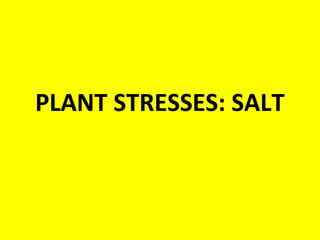
Salt stress in HIGHER PLANTS
- 3. INTRODUCTION • When irrigation water contains a high concentration of solutes and when there is no opportunity to flush out accumulated salts to a drainage system, salts can quickly reach levels that are injurious to salt-sensitive species. • It is estimated that about one-third of the irrigated land on Earth is affected by salt.
- 4. CLASSIFICATION OF PLANTS • Halophytes are native to saline soils and complete their life cycles in that environment • Glycophytes (literally “sweet plants”), or nonhalophytes, are not able to resist salts to the same degree as halophytes.
- 5. CLASSIFICATION OF PLANTS • Among crops, • maize, onion, citrus and bean are highly sensitive to salt; • cotton and barley are moderately tolerant; • sugar beet and date palms are highly tolerant .
- 6. Effects • Dissolved solutes in the rooting zone generate a low (more negative) osmotic potential that lowers the soil water potential. • The general water balance of plants is thus affected
- 7. • most plants can adjust osmotically when growing in saline soils. • Such adjustment prevents loss of turgor (which would slow cell growth)
- 8. Specific ion toxicity effects • Injurious concentrations of ions—particularly Na+ , Cl– , or SO42– — accumulate in cells. • An abnormally high ratio of Na+ to K+ and high concentrations of total salts inactivate enzymes and inhibit protein synthesis.
- 9. • Photosynthesis is inhibited when high concentrations of Na+ and/or Cl– accumulate in chloroplasts. • photophosphorylation may be affected.
- 10. • Plants minimize salt injury by excluding salt from meristems, particularly in the shoot, and from leaves that are actively expanding and photosynthesizing. • In plants that are salt sensitive, resistance to moderate levels of salinity • in the soil depends in part on the ability of the roots to prevent potentially harmful ions from reaching the shoots.
- 11. • Sodium ions enter roots passively (by moving down an electrochemical-potential gradient, so root cells must use energy to extrude Na+ actively back to the outside solution.
- 12. • have salt glands at the surface of the leaves. • The ions are transported to these glands, where the salt crystallizes and is no longer harmful
- 13. • Salt effects: – Plant Growth – Production – Survival
- 14. Salts: • - Humid areas – NaCl dominant • - Dry areas: sulfates – CaSO4 • Na2SO4 • MgSO4 • - alkaline (pH = 8 – 10)
- 15. • Ion toxicity – disruption of enzyme activity at high salinities • Ion imbalance: High Cl- concentrations - NO3- uptake inhibited • High Na+ replace Ca2+ in root cell membranes – loss of K+ from roots
- 16. • Mechanisms to deal with salinity: • - anatomical, morphological, physiological and biochemical • - adaptations - two categories: • - exclusion • - inclusion
- 17. Exclusion • Trait of most glycophytes – maintain low salt levels in roots: • - filtration – salts filtered out at plasmalemma of root parenchyma cells • - high levels of phospatidyl choline in plasmalemma restrict Cl- uptake – • excretion – high energy cost – decreased growth
- 18. Inclusion • Once salt enters root – mechanisms to resist or tolerate salinity – missing in glycophytes: • Transport prevention – salts kept in roots – stopped from entering xylem • active reabsorption of salts from xylem to older root cells • high energy (ATP) cost